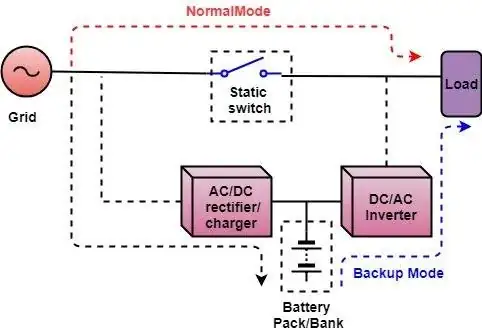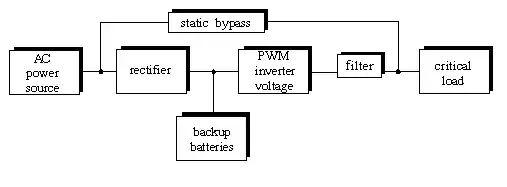Sounds to me like a design flaw.
Why wouldn't this work? No switching transient and the power supply to the servers (or whatever) fails only if both battery and AC power fail.

simulate this circuit – Schematic created using CircuitLab
Over the weekend, some server in the server room died because of a UPS battery failure while the AC power remained fine.
I don't see the reason for why this failure is inherent to the problem.
Revision: It finally occurred to me to look it up in Wikipedia, and they say there are 3 different designs, and the seamless switching design I might have been looking for is the Online/double-conversion design. All other designs have a hard switch from the AC mains to the output of the inverter.
So it just occurred to me, similar to how the power-generator with the power company is put online to the grid by carefully aligning the phase of the generator to the phase of the AC on the grid and then throwing the switch, can't they make an energy-efficient UPS that has the UPS output connected directly to the AC mains in parallel to the inverter where the amplitude and phase/frequency of the inverter output is adjusted with a control system very similar to a phase-lock loop so that the power contribution to the output from the inverter is zero or very small during normal operation. It's an AC source that is phase-locked to the mains with amplitude adjusted from fiddling with the switching transistors on the primary of the inverter output transformer. The amplitude is increased so that the net AC current is never delivering power to the inverter's output transformer but there is only a trickle of current coming out, under normal operating conditions.
Then, when the AC power main goes out, the inverter is taking over the load and the battery is supplying a lot more current to the switching transistors on the primary of the transformer. There would have to be a disconnect of the output from the mains, because when the power comes back at any random moment, we don't know that the inverter phase is in phase with the mains. Then the controller of the inverter would slowly adjust the phase of the output of the inverter to be in phase with now-energized mains, the output voltage would be adjusted to be the same as the mains, then the disconnect switch would be reconnected and the system would go back to "normal operation".
Does that make any sense?
Tim, what do you think of that?

